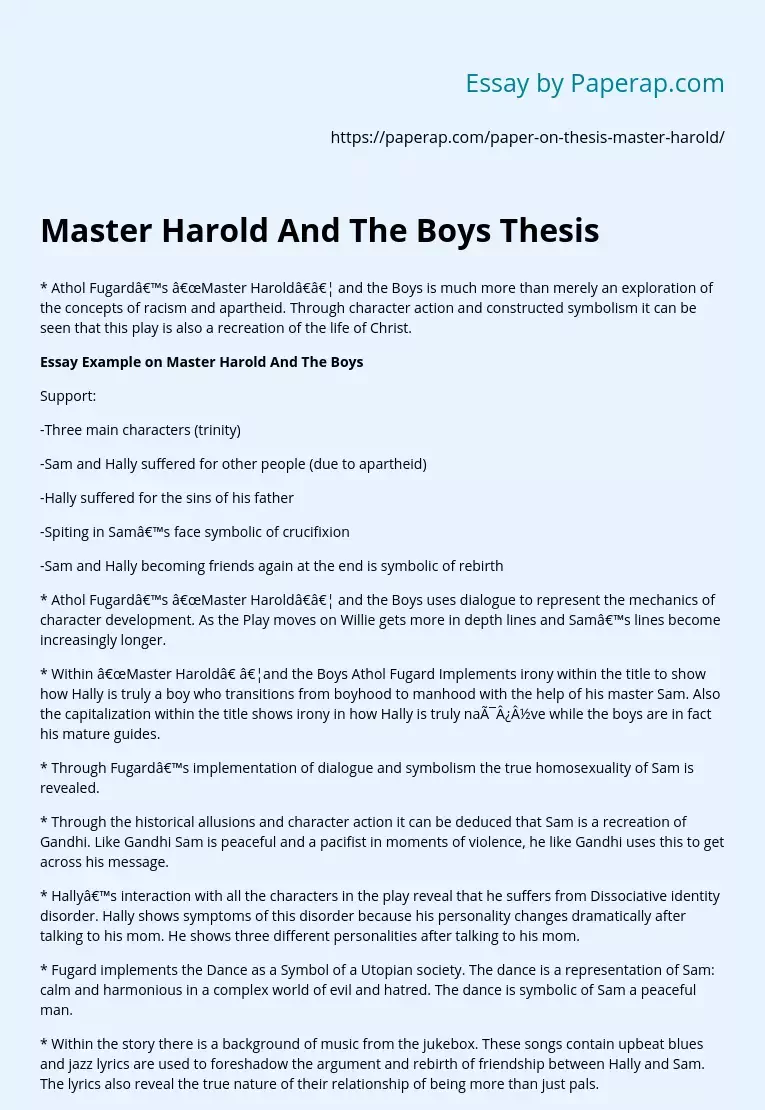Master Harold And The Boys Thesis
* Athol Fugard’s “Master Harold”… and the Boys is much more than merely an exploration of the concepts of racism and apartheid. Through character action and constructed symbolism it can be seen that this play is also a recreation of the life of Christ.
Essay Example on Master Harold And The Boys
Support:
-Three main characters (trinity)
-Sam and Hally suffered for other people (due to apartheid)
-Hally suffered for the sins of his father
-Spiting in Sam’s face symbolic of crucifixion
-Sam and Hally becoming friends again at the end is symbolic of rebirth
* Athol Fugard’s “Master Harold”… and the Boys uses dialogue to represent the mechanics of character development.
As the Play moves on Willie gets more in depth lines and Sam’s lines become increasingly longer.
* Within “Master Harold” …and the Boys Athol Fugard Implements irony within the title to show how Hally is truly a boy who transitions from boyhood to manhood with the help of his master Sam.
Also the capitalization within the title shows irony in how Hally is truly na�ve while the boys are in fact his mature guides.
* Through Fugard’s implementation of dialogue and symbolism the true homosexuality of Sam is revealed.
* Through the historical allusions and character action it can be deduced that Sam is a recreation of Gandhi. Like Gandhi Sam is peaceful and a pacifist in moments of violence, he like Gandhi uses this to get across his message.
* Hally’s interaction with all the characters in the play reveal that he suffers from Dissociative identity disorder.
Hally shows symptoms of this disorder because his personality changes dramatically after talking to his mom. He shows three different personalities after talking to his mom.
* Fugard implements the Dance as a Symbol of a Utopian society. The dance is a representation of Sam: calm and harmonious in a complex world of evil and hatred. The dance is symbolic of Sam a peaceful man.
* Within the story there is a background of music from the jukebox. These songs contain upbeat blues and jazz lyrics are used to foreshadow the argument and rebirth of friendship between Hally and Sam. The lyrics also reveal the true nature of their relationship of being more than just pals.
* Athol Fugard’s “Master Harold”… and the Boys has a much bigger focus then just racism and apartheid but it also has a great focus on friendship with struggles. Fugard uses many symbols throughout this play, but by far the most crucial one to the story is the kite. The kite itself is a synopsis of the play and the friendship.
* Fugard and Isben both use a situation in society as a catalyst to develop their plot and characters. In “Master Harold”… and the boys apartheid is the catalyst and in A Doll’s house women’s rights in society is the catalyst. Both of these catalysts are seen due to the diction used by the characters. In “Master Harold”… and the boys there is a greater use of Ebonics which provokes a greater sympathy for the characters in this play then in A Doll’s house.
Master Harold And The Boys Thesis. (2019, Nov 27). Retrieved from https://paperap.com/paper-on-thesis-master-harold/

